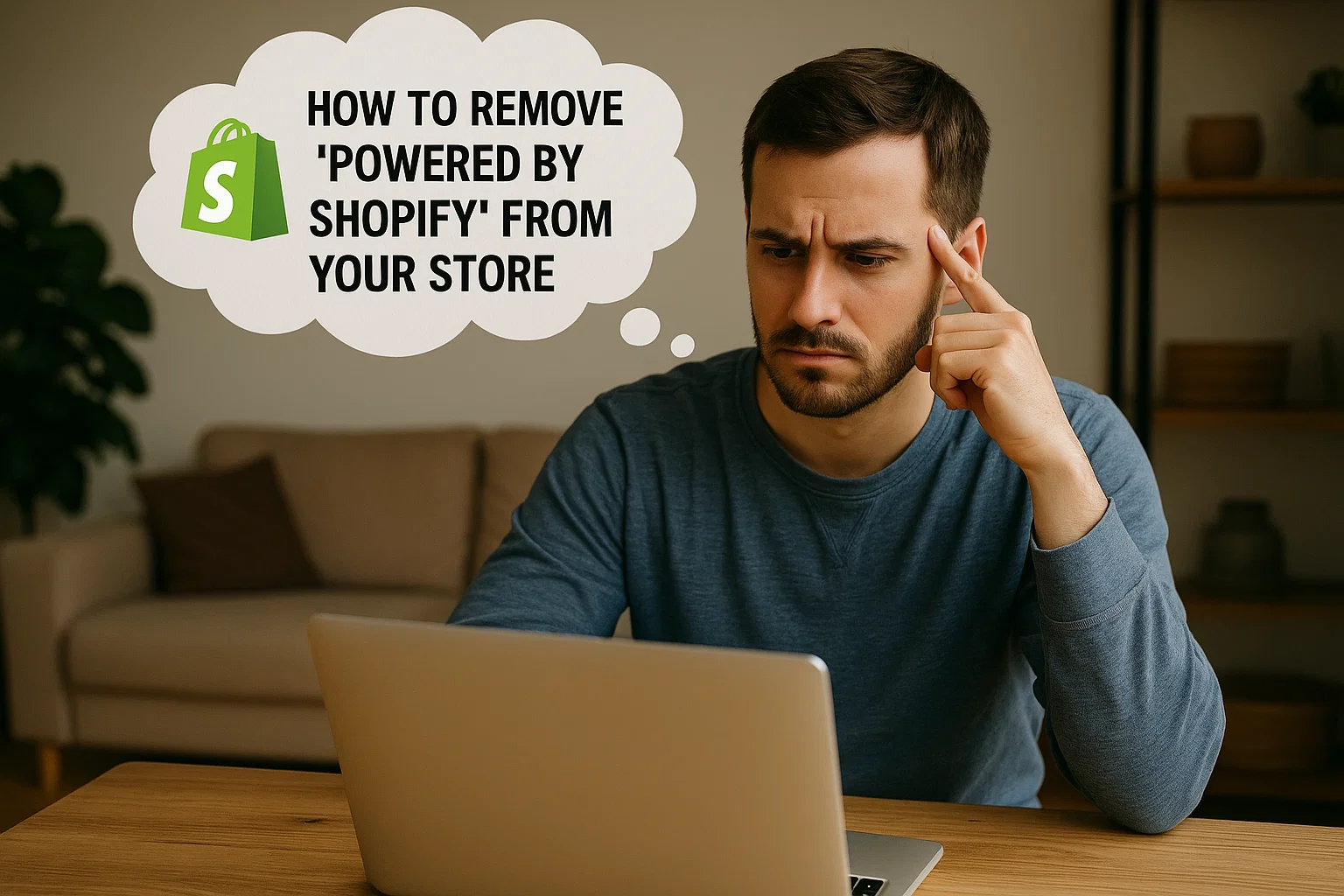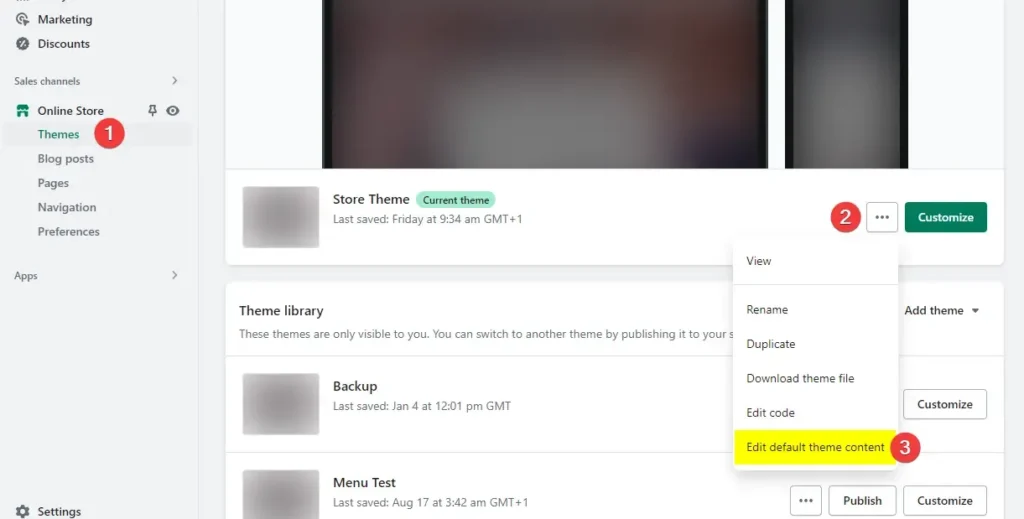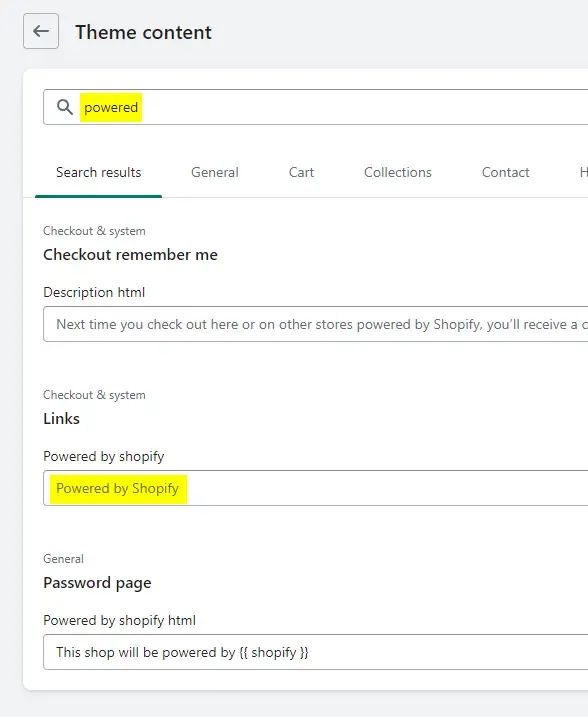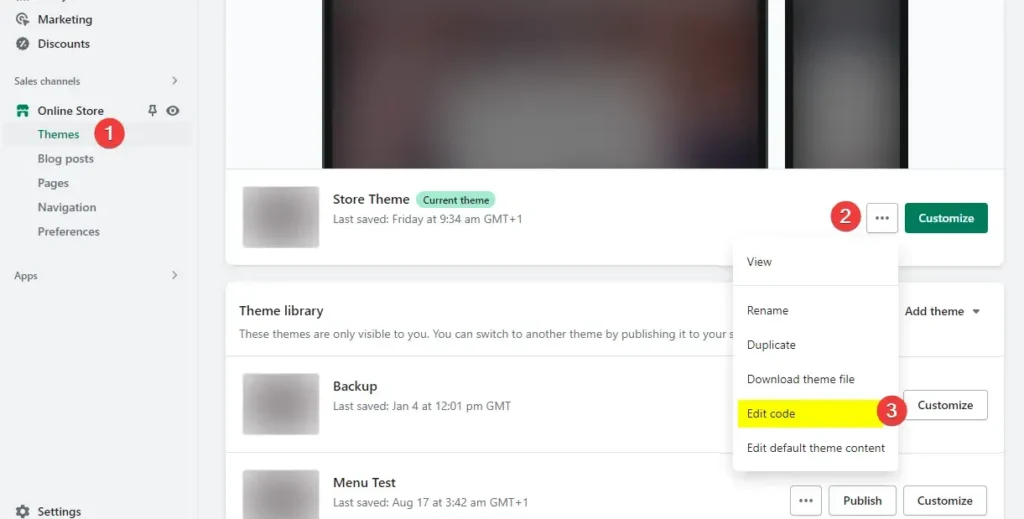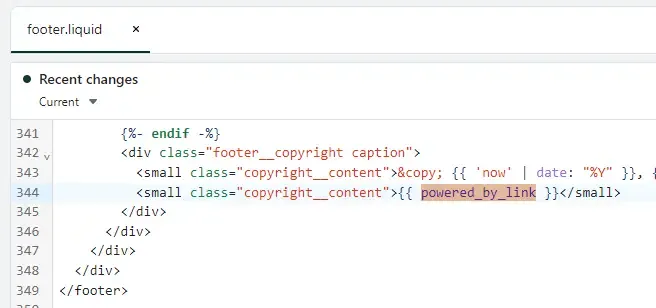Your online store’s first impression can make or break a sale. In today’s hyper-competitive eCommerce world, every design element—from your logo to your footer—contributes to how customers perceive your brand. One commonly overlooked but highly visible element is the “Powered by Shopify” text that appears at the bottom of most Shopify themes by default.
While Shopify proudly brands itself on millions of stores, that tiny phrase may be subtly undermining your credibility and uniqueness. If you’re building a serious eCommerce brand, it’s important to take full control of your storefront’s appearance—and that includes the footer.
In this blog, we’ll show you exactly how to remove Powered by Shopify from your store, using multiple methods—no technical skills required. We’ll also dive into why it’s smart to get rid of Powered by Shopify and what benefits it brings for branding, trust, and conversion rates.
Whether you’re a seasoned seller or launching your first Shopify store, this guide will walk you through everything you need to know—step by step.
Need help while customizing your theme? Here’s how to contact Shopify support in 2025 if you run into any issues.
What Does ‘Powered by Shopify’ Mean?
If you’ve ever scrolled to the bottom of your Shopify store—or any other Shopify-powered site—you’ve likely noticed the phrase Powered by Shopify in the footer. This small text line is automatically included in most Shopify themes and is part of the platform’s branding.
Why Is It There?
Shopify adds this footer as a form of brand visibility. It acts as a soft endorsement: “This store was built using Shopify.” For new or free theme users, it’s a default setting that signals the platform behind the storefront.
From Shopify’s perspective, this is beneficial. Every time someone visits your site, they see the Shopify name. But for store owners trying to build a standalone brand, this phrase can feel out of place.
Where Does It Appear?
The “Powered by Shopify” text typically appears:
In the footer section of most free Shopify themes
On password-protected pages (coming soon/maintenance)
Occasionally within checkout or email templates (depending on theme customization)
Is It Mandatory to Keep?
No. Shopify allows store owners to remove or customize this phrase—regardless of whether you’re using a free or paid theme. However, it does require a bit of digging in your theme settings or code editor.
Removing this footer won’t violate any Shopify policy. It’s a completely legitimate way to make your store look more polished and professionally branded.
SEO Tip: Customizing or removing default template elements—like this one—helps reduce duplicated design footprints across Shopify stores, which can have minor but meaningful impacts on user trust and search engine perception.
Start a free trial and enjoy 3 months of Shopify for $1/month
🚀 Start Shopify TrialTrusted by over 2,000,000 businesses worldwide
Why You Should Remove ‘Powered by Shopify
Removing the “Powered by Shopify” text isn’t just about aesthetics—it’s a strategic move that impacts branding, trust, and even conversions. While the default footer is harmless on the surface, keeping it can subtly dilute your store’s professionalism and identity.
Below are the top reasons why store owners should seriously consider getting rid of this default footer credit.
Elevate Your Brand Identity
The moment a customer lands on your site, they’re subconsciously evaluating your brand. A clean, customized footer reinforces that your business is established, independent, and professional. By removing the Shopify credit, you’re sending a subtle message: “This is our brand. We own it.”
Leaving it in place can suggest a lack of customization—or worse, a lack of attention to detail.
Increase Customer Trust
Trust plays a massive role in online shopping. When a footer includes generic or platform-branded text like “Powered by Shopify,” some customers may view your store as less authoritative or even “unfinished.”
By removing or replacing it with your own brand name or legal footer, you instantly appear more legitimate. You look like a business, not a template.
Pro Tip: Replace “Powered by Shopify” with your business name and year for a credible, custom feel:
© 2025 [YourBrandName]. All rights reserved.
Stand Out in a Saturated Market
Millions of stores use Shopify, and many of them keep the default settings—including that same footer text. If you want to differentiate your store and leave a lasting impression, every detail matters. Customizing small elements like the footer sets you apart from the “template crowd.”
Branding is a competitive edge. Clean design + customized elements = memorable experience.
Boost SEO & Engagement
While removing the “Powered by Shopify” text alone won’t shoot your site to page one, it plays a small role in a larger SEO and UX strategy:
Cleaner code: Less bloat in your footer means faster rendering.
Better engagement: A trustworthy design encourages users to stay longer.
Improved branding signals: Unique branding across your site helps search engines identify and trust your domain.
Align With Serious eCommerce Standards
Big brands don’t advertise their platforms. Amazon doesn’t say “Powered by AWS.” Your store shouldn’t advertise its backend either. If you’re running paid ads, optimizing for conversions, and scaling product lines, your site should reflect a fully branded experience—down to the footer.
Learn how to effectively add customer reviews on your Shopify store to enhance trust, increase engagement, and boost overall sales conversions.
How to Remove Powered by Shopify (Step-by-Step Guide)
The “Powered by Shopify” tagline appears by default in most Shopify themes. While it may seem harmless, it links back to Shopify’s homepage, and for many store owners, that’s an unwanted distraction from their brand identity. The good news is: you can remove or even replace it—with or without code.
Let’s break down the two best ways to get rid of it, starting with the simplest one.
Method 1: Remove “Powered by Shopify” Without Code (The Easy Way)
This method works for most free and premium Shopify themes, especially those based on Shopify’s Online Store 2.0 architecture.
Steps:
From your Shopify admin, go to:
Online Store > ThemesClick the “…” (three-dot menu) next to your active theme.
Select Edit default theme content from the dropdown.
Image Source: LOGEIX
- In the search bar, type “powered” to locate the corresponding text field.
Click into the “Powered by Shopify” field and press the spacebar to clear the content. Then click Save.
Once saved, the footer text will disappear from your live store.
Limitation:
If you try to replace the default text with something like “Free Shipping Worldwide,” the link will still point to Shopify.com. Unfortunately, the admin interface doesn’t allow you to change the destination URL—only the visible text.
If you want full control over the link and behavior, move on to the more flexible solution below.
Method 2: Remove or Replace It Using Theme Code (The Flexible Way)
This approach gives you full control over both the text and the hyperlink structure of your store’s footer.
Steps:
Go to Online Store > Themes, then click the “…” menu next to your theme and select Edit code.
2. In the left sidebar of the code editor, open the Sections folder and locate the file called footer.liquid.
If you don’t see it, use the search bar to type “footer”.
Open footer.liquid, then use Ctrl + F or Cmd + F to search for: powered_by_link
This variable outputs Shopify’s default “Powered by Shopify” anchor tag.
What is {{ powered_by_link }}?
This is a global Liquid object used in Shopify themes. It automatically generates a localized link pointing to Shopify’s homepage, like this:
<a target="_blank" rel="nofollow" href="https://www.shopify.com?utm_campaign=poweredby&utm_medium=shopify&utm_source=onlinestore">Powered by Shopify</a>You don’t need to remove this tag from every line of code. Instead, override it using one of the two cleaner methods below.
Option 1: Remove It Completely (Safe & Reversible)
At the top of your footer.liquid file, add this line:
{% assign powered_by_link = %}What this does:
Overrides the default object with an empty value
Leaves the rest of your code untouched
Makes it easy to undo or re-enable in the future
Option 2: Replace It With a Custom Link (Recommended)
Want to show a branded message or a link to your contact page instead?
Use this code instead:
{% capture powered_by_link %}<a target="_blank" rel="nofollow" href="https://YOURSTORE.com">YOUR TEXT</a>{% endcapture %}You can change:
The URL (https://yourstore.com/)
The anchor text (Your Custom Text)
Add/remove attributes like “target=”_blank” or rel=”nofollow”
Pro Tip: Using {% capture %} instead of replacing all instances of
{{ powered_by_link }}improves maintainability and reduces error risk.
Image Source: Screenshots in this section are sourced from Logeix and are used for informational and educational purposes only.
Once your store is fully branded, the next step might be multi-channel selling—here’s how to connect Shopify to Amazon easily.
What should you replace ‘Powered by Shopify’ with?
Now, once you know how to remove “Powered by Shopify” text, the next step is to decide what—if anything—you should put in its place. Leaving it completely blank is fine, but replacing it with something intentional can enhance your store’s credibility, user experience, and even SEO.
Here are some smart alternatives you can use to reinforce your brand’s professionalism and build trust with visitors:
Your Store Name and Copyright Info
A popular and highly professional option is to simply display your business name with a copyright year. This adds a touch of legitimacy while also subtly reassuring customers that your site is active and up to date.
Example: “© 2025 UrbanTech Apparel. All Rights Reserved.”
A Trust Signal or Value Proposition
You can also use this space to communicate a key value your brand offers—something that differentiates you or builds immediate trust.
Example: “Fast, Free Shipping on All U.S. Orders”
Example: “Secure Checkout • Hassle-Free Returns”
These short phrases act as subtle reassurance, especially on mobile where the footer is often seen during cart or checkout navigation.
Navigation Links or Legal Pages
Some store owners use this section to house practical links, such as:
Privacy Policy
Terms of Service
Refund Policy
Contact Us
These links serve a dual purpose: improving user navigation and contributing to legal compliance.
A Tagline or Brand Mission
If your brand has a strong identity or mission, the footer is a great place to reinforce it without distracting from product content.
Example: “Designed for Creators. Built for Impact.”
Example: “Ethically Made. Purposefully Priced.”
This subtle messaging can create emotional resonance and align with your audience’s values.
Social Proof or Payment Icons (via theme apps)
While not text-based, some brands enhance this area visually by integrating:
Social media icons (Facebook, Instagram, TikTok)
Accepted Shopify payment methods (Visa, PayPal, Klarna)
These help build trust and credibility, especially for first-time visitors.
Find the best third-party logistics providers to help scale your Shopify business through fast, reliable, and cost-effective order fulfillment.
Start a free trial and enjoy 3 months of Shopify for $1/month
🚀 Start Shopify TrialTrusted by over 2,000,000 businesses worldwide
Common Mistakes to Avoid When Removing ‘Powered by Shopify’
Shopify allows multiple themes to be installed in your dashboard, but only one is active at a time. A frequent mistake is editing a backup or unpublished theme by accident.
Always double-check that you’re editing the correct live theme under Online Store > Themes > Current Theme.
Deleting Code Instead of Overriding It
In the code editor, it’s tempting to simply delete the {{ powered_by_link }} snippet. While that works, a safer and cleaner approach is to override the variable instead of removing it completely. This ensures that:
You can revert the change easily
You avoid layout issues if the tag appears in multiple locations
Not Backing Up Before Editing Code
Anytime you’re editing your theme’s code, it’s smart to create a duplicate version of your theme beforehand. That way, if anything goes wrong, you can restore your store to a working version without delay.
Pro Tip: Click Actions > Duplicate on your current theme before making any changes.
Forgetting to Save Changes
It may seem obvious, but it’s common to walk through the steps and forget to click “Save” before exiting. Always preview and save your theme after making any edits—especially in the code editor or language settings.
Assuming It’s a One-Time Fix
Some themes (especially ones with regular developer updates) may reintroduce the powered_by_link variable when updated. If you later change your theme or publish a fresh version, double-check that the text hasn’t returned.
Not Previewing on Mobile
Your footer may look fine on desktop but display differently on mobile. After removing or replacing the Shopify branding, make sure to preview your store on multiple devices to ensure that spacing, alignment, and formatting all appear clean.
Overlooking Other Shopify Mentions
Removing the footer is a great start, but there may be other Shopify-branded elements on:
Password-protected pages (like “coming soon” or “under maintenance”)
Email templates
Checkout pages (if you’re not on Shopify Plus)
Perform a quick audit across your storefront to fully de-platform any unnecessary Shopify branding.
Master proven tactics for driving high-quality traffic to your Shopify store using SEO, social media, paid ads, and influencer marketing.
Final Thoughts: How to Remove Powered by Shopify
Removing “Powered by Shopify” from your store’s footer is more than just a design decision—it’s a subtle yet powerful step toward full brand ownership. Whether you choose the no-code method or take control through the theme’s Liquid files, customizing this detail allows your store to stand out, look more trustworthy, and reflect the identity you’ve worked hard to build.
In a crowded eCommerce landscape, generic elements like platform credits can diminish your store’s professional appearance. By taking the time to remove or replace that footer text, you’re signaling that your brand is original, intentional, and here to stay.
Whether you replace it with a copyright statement, a brand slogan, or nothing at all—the key is that it’s now yours.
Stay ahead of the curve with trending, high-demand products to sell on your Shopify store in 2025.
FAQ: How to Remove Powered by Shopify
What is the “Powered by Shopify” message and why does it show up in my store’s footer?
This phrase is a default footer tag added to most Shopify themes, indicating that your website is built on the Shopify platform. It appears automatically on live stores and password-protected pages to promote Shopify’s branding. While it’s harmless, many store owners choose to remove it to create a more custom, professional brand experience.
Is it necessary to remove the Shopify branding from my store’s footer?
It’s not required, but it’s highly recommended—especially if you’re building a long-term brand. Leaving platform credits like “Powered by Shopify” in your footer can make your store feel generic or unfinished. By removing it, you improve your site’s credibility, reinforce your own brand, and create a more polished user experience.
Am I allowed to replace the default Shopify footer text with my own?
Yes, absolutely. Shopify gives you full control over your store’s theme, so you’re free to remove or replace the footer text with a copyright message, a slogan, navigation links, or anything else that aligns with your branding. Just keep in mind that if you want to change both the text and the destination link, you’ll need to edit your theme’s code directly.
Need Help? Let’s Build Your Shopify Store the Smart Way With – Stores Automation
Why build alone when you can have a team do it for you? At Stores Automation, we create fully automated, done-for-you Shopify stores that are designed to grow while you focus on profits. No tech stress, no guesswork—just a streamlined system that works for you 24/7.
From store setup to product integration, branding, and automation—we handle everything so you don’t have to.
Call us: 302-204-8244
Email us: info@storesautomation.com
Sign up here and let us take it from there.
Let’s build you a store that runs on autopilot—because your time is better spent earning.
